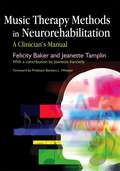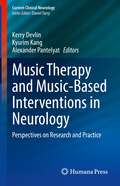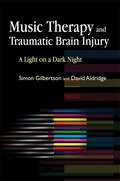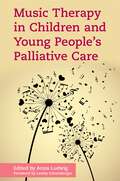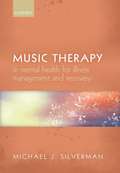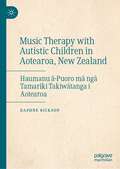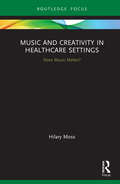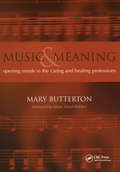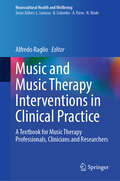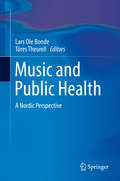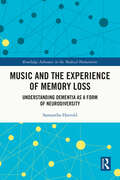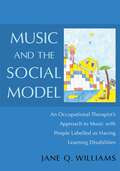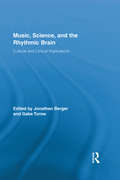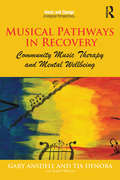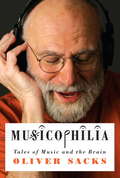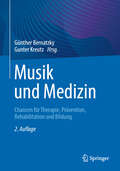- Table View
- List View
Music Therapy Methods in Neurorehabilitation: A Clinician's Manual
by Felicity Baker Jeanette Tamplin Jeanette Kennelly Barbara L WheelerThe value of music therapy in neurological rehabilitation is increasingly recognised and this practical manual provides comprehensive guidance for clinicians on the application of music therapy methods in neurorehabilitation. Felicity Baker and Jeanette Tamplin combine research findings with their own clinical experience and present step-by-step instructions and guidelines on how to implement music therapy techniques for a range of therapeutic needs. Photographs clearly illustrate interventions for physical rehabilitation, for example through the use of musical instruments to encourage targeted movement. The chapter on cognitive rehabilitation includes resources and lists suitable songs for use in immediate memory or abstract thinking tasks, among others. In her chapter on paediatric patients, Jeanette Kennelly demonstrates how procedures can be adapted for working clinically with children. A comprehensive list of terminology commonly used in neurological rehabilitation is also included. Music Therapy Methods in Neurorehabilitation will prove an invaluable reference book for music therapy clinicians and students. It is also suitable for work with other populations, in particular for work in special education.
Music Therapy and Music-Based Interventions in Neurology: Perspectives on Research and Practice (Current Clinical Neurology)
by Kerry Devlin Kyurim Kang Alexander PantelyatThis book synthesizes knowledge about the myriad ways music can support the physical and psychosocial needs of people living with neurological diagnoses. It may be a useful tool for those working or training as music therapists, as well as clinicians and patients interested in the use of music and rhythm to address individualized healthcare goals. The editors of this book advocate for a collaborative, holistic approach to the implementation of music-based interventions, acknowledging that different (and at times, conflicting) approaches do exist – and that different patients may require exploration of different approaches to have their needs and desires met in ways most meaningful to them. The book’s many contributors embody this desire to hold space for wide-ranging views on clinical practice through the ways they share their own perspectives as music therapists, neurologists, nurses, speech and language pathologists, and neuroscience researchers from across the globe.Each chapter is centered around clinical work in context with a specific patient community – be that a diagnosis (e.g., movement disorders), shared culture (e.g., autistic culture), disease stage (e.g., end of life), or targeted clinical need (e.g., psychosocial support and/or functional performance) – and features a summary of available research with case examples and clinical descriptions to highlight different conceptualizations of the role of music in the care of patients with neurologic diagnoses.
Music Therapy and Traumatic Brain Injury: A Light on a Dark Night
by David Aldridge Simon GilbertsonMusical improvisation is an increasingly recognised rehabilitative therapy for people who have experienced traumatic brain injury initially thought to be `unreachable' or `non-responsive'. Music Therapy and Traumatic Brain Injury demonstrates how music therapy can be used to attend to the holistic, rather than purely functional, needs of people affected by severe head trauma. Divided into three parts, the first section provides an introduction to the effects brain injury has on a person's livelihood. The second is a comprehensive review of available literature on the use of music therapy in the neurorehabilitative setting. The final section examines three case studies designed according to `therapeutic narrative analysis', an adaptive research method that uses interviewing and video, which focuses on the unique relationship between the professional and the patient. This book will give clinicians key notes for practice and a vision of the integral role music therapy can have in the successful rehabilitation from brain injury.
Music Therapy in Children and Young People's Palliative Care
by Mike Gilroy Kathryn Cave Kirsty Ormston Victoria Kammin Cathy Ibberson Janet McLachlan Dr Giorgos Tsiris Sarah Hodkinson Nathan Vanstone-Howe Joanne Edgar Dr Daphne RicksonThis book brings together music therapists who have worked in the challenging and rewarding world of children's palliative care. Examining techniques from working just with the breath, to technological advances in music therapy such as assistive recording and electronic downloading, it highlights the benefits music therapy can bring when working alongside children and young people. Drawing on the knowledge of expert music therapists, the book provides accessible guidance that practitioners can apply to their own work, including on professional development as part of a multi-disciplinary team, service evaluation, and managing publicity in the hospice setting. It addresses work with different client groups, such as teenagers, and discusses therapy with family members, including siblings. Music therapists and healthcare practitioners will be provided with the tools to reflect on their own professional challenges and deepen their understanding of the important role of music therapy in this sector.
Music Therapy in Mental Health for Illness Management and Recovery
by Michael J. SilvermanMany music therapists work in adult mental health settings after qualifying. For many, it will be a challenging and even daunting prospect. Yet until now, there has been no psychiatric music therapy text providing advice on illness management and recovery. <p><p> This essential book fills the gap in the literature, providing the necessary breadth and depth to inform readers of the psychotherapeutic research base and show how music therapy can effectively and efficiently function within a clinical scenario. The book takes an illness management and recovery approach to music therapy specific to contemporary group-based practice. It is also valuable for administrators of music therapy, providing innovative theory-based approaches to psychiatric music therapy, developing and describing new ways to conceptualize psychiatric music therapy treatment, educating music therapists, stimulating research and employment, and influencing legislative policies. <p> An important aim of the book is to stimulate both critical thought and lifelong learning concerning issues, ideas, and concepts related to mental illness and music therapy. Critical thinking and lifelong learning have been - and will likely continue to be - essential aspirations in higher education. Moreover, contemporary views concerning evidence-based practice rely heavily upon the clinician's ability to think critically, seek a breadth of contradicting and confirmatory evidence, implement meta-cognition to monitor thoughts throughout processes, and synthesize and evaluate knowledge to make informed clinical decisions relevant and applicable to idiosyncratic contextual parameters. <p> For both students and clinicians in music therapy, this is an indispensable text to help them learn, develop, and hone their skills in music therapy
Music Therapy with Autistic Children in Aotearoa, New Zealand: Haumanu ā-Puoro mā ngā Tamariki Takiwātanga i Aotearoa
by Daphne RicksonIn this unique text, ten cases of music therapy with autistic children (tamariki takiwātanga) are critiqued through the eyes of family members and other autism experts. Rickson uses her wealth of experience to contextualise their rich observations in a thorough review of research and practice literature, to illustrate the ways music therapists engage autistic children in the music therapy process, highlight the various ways music therapy can support their health and well-being, and demonstrate how music therapy processes align with good practice as outlined in the New Zealand Autism Spectrum Disorder Guideline.
Music and Creativity in Healthcare Settings: Does Music Matter?
by Hilary MossThrough a series of vivid case studies, Music and Creativity in Healthcare Settings: Does Music Matter? documents the ways in which music brings humanity to sterile healthcare spaces, and its significance for people dealing with major illness. It also considers the notion of the arts as a vessel to explore humanitarian questions surrounding serious illness, namely what it is to be human. Overarching themes include: taking control; security and safety; listening; the normalization of the environment; being an individual; expressing emotion; transcendence and hope and expressing the inexpressible. With an emphasis on service user narratives, chapters are enriched with examples of good practice using music in healthcare. Furthermore, a focus on aesthetic deprivation contributes to debates on the intrinsic and instrumental value of music and the arts in modern society. This concise study will be a valuable source of inspiration for care givers and service users in the health sector; it will also appeal to scholars and researchers in the areas of Music medicine and music Therapy, and the Medical Humanities.
Music and Meaning: Opening Minds in the Caring and Healing Professions
by Mary ButtertonThis fascinating and illuminating study brings together a wealth of information gained from individuals who reveal how music has had an effect on their lives. It unveils how music plays an important part in counselling and therapy and links the disciplines of the philosophy of music to neuroscience, developmental psychology and psychoanalysis. Psychotherapists, counsellors and therapists will find this book thought-provoking and invaluable reading; as well as doctors, nurses and those working with the elderly and people with developmental difficulties. All those with an interest in music and how it can affect their lives will also find this book interesting reading.
Music and Moral Management in the Nineteenth-Century English Lunatic Asylum (Mental Health in Historical Perspective)
by Rosemary GoldingThis book traces the role played by music within asylums, the participation of staff and patients in musical activity, and the links drawn between music, health, and wellbeing. In the first part of the book, the author draws on a wide range of sources to investigate the debates around moral management, entertainment, and music for patients, as well as the wider context of music and mental health. In the second part, a series of case studies bring to life the characters and contexts involved in asylum music, selected from a range of public and private institutions. From asylum bands to chapel choirs, smoking concerts to orchestras, the rich variety of musical activity presents new perspectives on music in everyday life. Aspects such as employment practices, musicians’ networks and the purchase and maintenance of musical instruments illuminate the ‘business’ of music as part of moral management. As a source of entertainment and occupation, a means of solace and self-control, and as a device for social gatherings and contact with the outside world, the place of music in the asylum offers valuable insight into its uses and meanings in nineteenth-century England.
Music and Music Therapy Interventions in Clinical Practice: A Textbook for Music Therapy Professionals, Clinicians and Researchers (Neurocultural Health and Wellbeing)
by Alfredo RaglioThis textbook aims to provide practical and comprehensive guidance on the application of music and music therapy in clinical settings. The chapters are written with an evidence-based approach. The first part of the volume defines the psychological, biological, and neuroscientific basis of the therapeutic use of music. Then, various chapters describe the main application techniques (both active and receptive) exploring their therapeutic rationale, purposes, applications in preventive and therapeutic-rehabilitation settings, and possible methods of assessment. An overview of the main clinical areas addressed by music-based therapeutic interventions is also presented, including references to scientific literature, systematic and meta-analytic reviews as well as studies with rigorous methodologies (Randomized Controlled Trials). The final chapter focuses on research, outlining the current state of the art and possible future scenarios within this specific context. The authors of this book are scholars and practitioners in music therapy and related disciplines with recognized experience in clinical and research settings. This book will be an invaluable tool for individuals with an interest in music therapy and its application in clinical settings, such as students studying music therapy, practicing music therapists, researchers, and professionals in related disciplines.
Music and Public Health: A Nordic Perspective
by Lars Ole Bonde Töres TheorellFrom the Nordic countries (Denmark, Norway, Sweden and Finland) comes an exciting source of theoretical approaches, epidemiological findings, and real-life examples regarding the therapeutic and health-enhancing effects of music. Experts across fields including psychology, neurology, music therapy, medicine, and public health review research on the benefits of music in relieving physiological, psychological, and socioemotional dysfunction. Chapters link musical experiences (listening and performing, as well as involvement in movement, dance, and theatre) to a wide range of clinical and non-clinical objectives such as preventing isolation, regulating mood, reducing stress and its symptoms, and treating dementia. And the book’s section on innovative music-based interventions illustrates opportunities for incorporating musical activities into public health programs. Among the topics covered are: · Associations between the use of music, cultural participation and health-related outcomes in adult Scandinavian populations · Music practice and emotion handling · How music translates itself biologically in the body · Music as a forum for social-emotional health · Participation and partnership as core concepts in music and public health · Music therapy as health promotion for mothers and children at a public health clinic Music and Public Health will gain interested readers among researchers, teachers, students, and clinicians in the fields of music education and therapy, as well as researchers and students of public health who are interested in the influence of culture and the arts. The book also will be relevant to administrators in public health services.
Music and the Experience of Memory Loss: Understanding Dementia as a Form of Neurodiversity (Routledge Advances in the Medical Humanities)
by Samantha HarroldThis book is a creative and critical exploration of the memory loss experience. Drawing on in-depth case studies based on primary research, interviews, approaches from music therapy, and theory from Derrida, Malabou, and Royle, it explores how we might better support people living with memory loss.Telling the story of an interpretative phenomenological analysis investigation, this innovative book focuses on conversations with ten people living with memory loss in a nursing home, alongside interviews with the pioneering dementia campaigner Wendy Mitchell. The author argues that, for residents who are living with memory loss, both the nursing home environment and the memory loss experience are uncanny. She considers how archival impulses may manifest themselves at the end of life, before exploring theories of both artistic plasticity and neuroplasticity, proposing that the memory loss state might be thought of as a kind of neurodiversity. The book concludes with suggestions for future methods that alleviate disorientation for people living with memory loss and help with acceptance, the reduction of stress, and better outcomes across multiple disciplines and practices, including music therapy, community musicianship, and the nursing home environment itself.A better understanding of how it feels to live with memory loss is necessary for the development and improvement of practices that are designed to help the memory loss community. This book is an invaluable contribution to research around memory loss, for scholars and practitioners interested in medical humanities, dementia, social care nursing, occupational therapy, and music therapy, among others.
Music and the Nerves, 1700-1900
by James KennawayThe relationship between music and the nervous system is now the subject of intense interest for scientists and people in the humanities, but this is by no means a new phenomenon. This volume sets out the history of the relationship between neurology and music, putting the advances of our era into context.
Music and the Social Model: An Occupational Therapist's Approach to Music with People Labelled as Having Learning Disabilities
by Jane Williams Rachel PurtellMusic has always been an essential part of what it is to be human and yet not everyone has access to the music-based opportunities others take for granted. Motivated by the belief that individuals are disabled by society rather than any impairment they might have, Jane Williams sets out to show how someone with learning difficulties can engage with music in as many diverse and fulfilling ways as the rest of their community and generation. This practical guide will equip you with everything you need to know to help empower people with learning difficulties to experience and enjoy music, meaningfully. It sets out activity ideas in the context of existing Occupational Therapy models and offers a host of tips, resources and ready-to-use themed lesson plans to inspire and enrich your practice. There are also many practical examples and real-life success stories that show how to put the theory into practice, including downloadable tracks composed and performed by The LA Buskers, a band Jane works with. Accessible, practical and inspirational, the unique approaches described in this book will be of immeasurable interest to occupational therapists, social care workers responsible for planning and delivering activity programmes as well as community musicians.
Music, Science, and the Rhythmic Brain: Cultural and Clinical Implications (Routledge Research in Music)
by Jonathan Berger Gabe TurowThis book studies the effects of repetitive musical rhythm on the brain and nervous system, and in doing so integrates diverse fields including ethnomusicology, psychology, neuroscience, anthropology, religious studies, music therapy, and human health. It presents aspects of musical rhythm and biological rhythms, and in particular rhythmic entrainment, in a way that considers cultural context alongside theoretical research and discussions of potential clinical and therapeutic implications. Considering the effects of drumming and other rhythmic music on mental and bodily functioning, the volume hypothesizes that rhythmic music can have a dramatic impact on mental states, sometimes catalyzing profound changes in arousal, mood, and emotional states via the stimulation of changes in physiological functions like the electrical activity in the brain. The experiments presented here make use of electroencephalography (EEG), galvanic skin response (GSR), and subjective measures to gain insight into how these mental states are evoked, what their relationship is to the music and context of the experience, and demonstrate that they are happening in a consistent and reproducible fashion, suggesting clinical applications. This comprehensive volume will appeal to scholars in cognition, ethnomusicology, and music perception who are interested in the therapeutic potential of music.
Music, The Brain, And Ecstasy
by Robert JourdainWhat makes a distant oboe's wail beautiful? Why do some kinds of music lift us to ecstasy, but not others? How can music make sense to an ear and brain evolved for detecting the approaching lion or tracking the unsuspecting gazelle? Lyrically interweaving discoveries from science, psychology, music theory, paleontology, and philosophy, Robert Jourdian brilliantly examines why music speaks to us in ways that words cannot, and why we form such powerful connections to it. In clear, understandable language, Jourdian expertly guides the reader through a continuum of musical experience: sound, tone, melody, harmony, rhythm, composition, performance, listening, understanding--and finally to ecstasy. Along the way, a fascinating cast of characters brings Jourdian's narrative to vivid life: "idiots savants" who absorb whole pieces on a single hearing, composers who hallucinate entire compositions, a psychic who claims to take dictation from long-dead composers, and victims of brain damage who can move only when they hear music. Here is a book that will entertain, inform, and stimulate everyone who loves music--and make them think about their favorite song in startling new ways.
Musical Pathways in Recovery: Community Music Therapy and Mental Wellbeing (Music and Change: Ecological Perspectives)
by Gary Ansdell Tia DeNora"Music triggered a healing process from within me. I started singing for the joy of singing myself and it helped me carry my recovery beyond the state I was in before I fell ill nine years ago to a level of well-being that I haven't had perhaps for thirty years." This book explores the experiences of people who took part in a vibrant musical community for people experiencing mental health difficulties, SMART (St Mary Abbotts Rehabilitation and Training). Ansdell (a music therapist/researcher) and DeNora (a music sociologist) describe their long-term ethnographic work with this group, charting the creation and development of a unique music project that won the 2008 Royal Society for Public Health Arts and Health Award. Ansdell and DeNora track the 'musical pathways' of a series of key people within SMART, focusing on changes in health and social status over time in relation to their musical activity. The book includes the voices and perspectives of project members and develops with them a new understanding of how music promotes their health and wellbeing. A contemporary ecological understanding of 'music and change' is outlined, drawing on and further developing theory from music sociology and Community Music Therapy. This innovative book will be of interest to anyone working in the mental health field, but also music therapists, sociologists, musicologists, music educators and ethnomusicologists. This volume completes a three part 'triptych', alongside the other volumes, Music Asylums: Wellbeing Through Music in Everyday Life, and How Music Helps: In Music Therapy and Everyday Life.
Musicophilia: Tales Of Music And The Brain (Picador Classic Ser.)
by Oliver SacksRevised and ExpandedWith the same trademark compassion and erudition he brought to The Man Who Mistook His Wife for a Hat, Oliver Sacks explores the place music occupies in the brain and how it affects the human condition. In Musicophilia, he shows us a variety of what he calls "musical misalignments." Among them: a man struck by lightning who suddenly desires to become a pianist at the age of forty-two; an entire group of children with Williams syndrome, who are hypermusical from birth; people with "amusia," to whom a symphony sounds like the clattering of pots and pans; and a man whose memory spans only seven seconds-for everything but music. Illuminating, inspiring, and utterly unforgettable, Musicophilia is Oliver Sacks' latest masterpiece.From the Trade Paperback edition.
Musik und Medizin: Chancen für Therapie, Prävention, Rehabilitation und Bildung
by Günther Bernatzky Gunter KreutzDieses Buch beleuchtet die Wirkungen von Musik auf Gesundheit, Wohlbefinden und Lebensqualität aus der Sicht interdisziplinärer, musikwissenschaftlicher und medizinischer Forschung. Hochrangige Expert*innen aus vielfältigen Fachgebieten stellen die wissenschaftlichen Grundlagen für medizinische, therapeutische, pädagogische und andere Anwendung vor. Inhaltlich spannt es den Bogen von den psychophysiologischen Grundlagen emotionaler Wirkungen des Musikhörens bis hin zu musikmedizinischen und -therapeutischen Interventionen. Musik erweist sich vielfach als äußerst wirksame, nahezu nebenwirkungsfreie und vergleichsweise kostengünstige unterstützende Strategie für Prävention, Therapie und Rehabilitation in vielen medizinischen Fachbereichen.Ein breites Spektrum musikalischer Aktivitäten einschließlich Musikhören, Laienmusizieren, Chorsingen, Tanzen und verschiedene Formen musiktherapeutischer Strategien steht den Erfordernissen unterschiedlicher Zielgruppen, individuellen Unterschieden, Vorlieben und kulturellen Hintergründen gegenüber. Die Neuauflage wurde aktualisiert und mit Inhalten zu COVID 19 und einer neuen Sektion zu gesundheitlichen Belastungen durch Musik erweitert.Ärzt*innen und medizinisches Personal in Sozial- und Pflegeberufen erhalten profunde Informationen über Chancen und Grenzen musikbezogener Angebote. Die Kapitel eignen sich ebenso als Einstiege für Wissenschaftler*innen zahlreicher Fachrichtungen aus Sozial-, Natur- und Geisteswissenschaft.
Musikermedizin in der Physiotherapie und Ergotherapie: Befund und Behandlung spielbedingter Beschwerden
by Clemens ZiesenitzIn diesem Buch werden die theoretischen Grundlagen der Musikermedizin sowie die besonderen Anforderungen und Belastungen von professionellen Musikerinnen und Musikern praxisorientiert vermittelt. Der herausfordernde Berufsalltag kann durch die asymmetrische Haltung, der statischen Beanspruchung am Instrument oder durch langanhaltende, repetitive Bewegungsabfolgen zu muskulären Dysbalancen oder Überlastungssyndromen führen. Der Autor beschreibt anhand häufiger Störungsbilder die Befunderhebung und Behandlung in der Physiotherapie und Ergotherapie Das Praxisbuch erweitert das Wissen auf diesem spezialisierten Gebiet und hilft dabei, Musikerinnen und Musiker bestmöglich zu unterstützen, um typische Beschwerden vorzubeugen und ihre Leistungsfähigkeit zu steigern.
MuskelRevolution: Konzepte und Rezepte zum Muskel- und Kraftaufbau
by Marco ToigoWie Sie effektiv Muskeln aufbauen In diesem ebenso informativen wie praxisnahen Buch, das auf dem neuesten Stand der Muskelforschung basiert, entschlüsselt Marco Toigo, welche Faktoren für einen erfolgreichen Muskel- und Kraftaufbau entscheidend sind. Zudem stellt er anschaulich dar, welche praktischen und wissenschaftlich fundierten Konsequenzen sich für Ihr Trainings- und Ernährungsverhalten ergeben. Dieses Werk bietet somit zeitgleich einen praktischen Leitfaden wie auch eine wissenschaftliche Erklärung zum „Wie“ bzw. „Warum“ eines effektiven und effizienten Krafttrainings. Die nun vorliegende 2. Auflage ist vollständig überarbeitet und bietet folgende Erweiterungen:Neueste wissenschaftliche Erkenntnisse zum Effekt von Krafttraining und Nahrungsprotein auf die Kurzzeit- und Langzeit-Proteinsynthese im Skelettmuskel Präsentation eines universellen Modells zur trainingsinduzierten Muskelhypertrophie Training nach neuromuskulären Kompartimenten Viele neue ergänzende Texte zu Begleitthemen wie Fettabbau und Herz-/Kreislauf-Training Auf den Punkt gebracht: Ergänzende KurzzusammenfassungenMarco Toigo entlarvt Fitness-Mythen, erklärt, was beim Muskelaufbau wirklich passiert, und verrät, welche Denkfehler Sie beim Training bremsen. Unterhaltsam und intelligent, mit praktischen Mucki-Tipps von Dr. Muscle. 20 MinutenEin hervorragender Begleiter für Alle, die sich intensiv oder professionell mit Fitness und Krafttraining befassen. boersenblatt.net
Muslim Midwives
by Avner GiladiThis book reconstructs the role of midwives in medieval to early modern Islamic history through a careful reading of a wide range of classical and medieval Arabic sources. The author casts the midwife's social status in premodern Islam as a privileged position from which she could mediate between male authority in patriarchal society and female reproductive power within the family. This study also takes a broader historical view of midwifery in the Middle East by examining the tensions between learned medicine (male) and popular, medico-religious practices (female) from early Islam into the Ottoman period and addressing the confrontation between traditional midwifery and Western obstetrics in the first half of the nineteenth century.
Muslime in Alltag und Beruf: Integration von Flüchtlingen
by Béatrice Hecht-El MinshawiIn diesem Buch erfahren alle, die Flüchtlingen und Asylbewerbern begegnen – privat wie beruflich –, wie sie zu einem guten Miteinander beitragen können. In Deutschland gibt es viele Neubürger und Migranten: Exilanten, Flüchtlinge und Asylbewerber. Ein Großteil kommt aus islamischen Gesellschaften und ist mit manchen anderen Normen und Werten aufgewachsen. Deshalb ist davon auszugehen, dass wir immer öfter Muslimen in Beruf und Alltag begegnen. Sie gehören zu uns. Damit das Zusammenleben und die Zusammenarbeit gelingt, ist ein fundiertes interkulturelles Wissen notwendig: kulturelle Gemeinsamkeiten und Unterschiede, Mentalitäten, Verhaltensregeln, Kommunikationsstrategien und Tabus. Dieses Praxisbuch hilft, Muslime zu verstehen und vermittelt Ideen zum gemeinsamen Handeln – mit zahlreichen Fallbeispielen und Checklisten. Es richtet sich als Beratungsbuch und Arbeitsgrundlage an alle Personen im deutschsprachigen Raum, die mit Muslimen zu tun haben, in privaten und öffentlichen Einrichtungen wie Behörden und Schulen und in Betrieben.
Muslimische Patienten pflegen
by Alexandra Von Bose Jeanette TerpstraIn Deutschland leben ca. 4 Millionen Muslime und die Zahl der älteren Migranten steigt. So versorgen beruflich Pflegende immer häufiger kranke und pflegebedürftige Menschen, die einen anderen kulturellen Hintergrund haben. In der medizinischen und pflegerischen Betreuung kommt es zwischen Migranten und Pflegepersonal durch die kulturellen Unterschiede oft zu Konfliktsituationen und Störungen im Behandlungs- und Stationsablauf. Auslöser sind Stereotype, Unwissenheit und Verständigungsschwierigkeiten. Die Autorinnen unterstützen mit dieser Praxisfibel einen konfliktfreien Umgang mit muslimischen Migranten. An einzelnen Fallsituationen aus dem Klinik- und Pflegealltag werden Probleme dargestellt, kulturelle Hintergründe erläutert und Handlungsanregungen vorgeschlagen. Pflegende erhalten konkrete Tipps wie sie häufig auftretende Stress- und Konfliktsituationen mit muslimischen Patienten meistern. Das Kapitel über die Grundlagen der islamischen Kultur, z.B. zum Wertesystem, Rituale, Rollenverhalten, Krankheitsverständnis, fördert das Verständnis für die andere Kultur und hilft Konflikten vorzubeugen. Einfach und praktisch: Ein speziell entwickelter Anamnesebogen für muslimische Patienten erleichtert es Pflegenden schon bei der Aufnahme auf die besonderen Bedürfnisse einzugehen und eine konfliktfreie Betreuung in der Einrichtung vorzubereiten. Ein Glossar erläutert die wichtigsten islamischen Begriffe. Für beruflich Pflegende im Krankenhaus und in Pflegeeinrichtungen, die sich auf die Bedürfnisse von Migranten einlassen möchten. Geeignet für die interne Fortbildung, die Praxisanleitung aber auch für den Sozialdienst und ehrenamtliche Besuchsdienste.
Mut und Maß statt Wut und Hass: Ressentiments angemessen begegnen und Verantwortung übernehmen
by Thomas GutknechtDieses Sachbuch lädt ein, in Zeiten äußerer Unruhe und Unsicherheit darüber nachzudenken, was das gute Leben bedroht, um dann in angemessenem Rahmen Verantwortung übernehmen zu lernen. Ein Schlüssel zum Verständnis persönlicher wie gesellschaftlicher Katastrophen ist das Wissen um das Ressentiment. Ressentiments werden befeuert durch Ängste, genährt durch Bedenken- und Gedankenlosigkeit. Folgen sind Kränkung, Schuldgefühle, Scham und Angst. Dieses Buch zeigt die Zusammenhänge auf und lädt ein, zu bedenken und im Fühlen zu verankern: Wir gehören nicht der Angst und können dem Ressentiment begegnen. Wie? Mit Mut in der Besorgnis und mit einem besonnenen Denken, das das Unrechtsempfinden aufzulösen vermag und Versöhnung anbahnen kann. Lesen Sie, wie Sie wacher werden und reifen. Verstehen Sie das Wesen von Ressentiment und warum es gute Gründe für Hoffnung gibt. Lassen Sie sich ermutigen, Verantwortung zu übernehmen und zu einem Vertrauen zu finden, das Menschen verbindet. Dies ist kein Ratgeber, der Tipps und Tricks verrät, und doch sind die Auswirkungen dieser Lektüre psychologisch, nah, spürbar. Aus dem Inhalt: I Einleitung – II Ressentiment – III Angst – IV Mut – V Hoffnung – VI Verantwortung. Der Autor: Thomas Gutknecht ist Philosoph und Theologe und leitet das Logos-Institut für Philosophische Praxis. Seine Themen sind z. B. Lebenskunst, Sozialphilosophie, Philosophie der Zeit und der Gesundheit.
